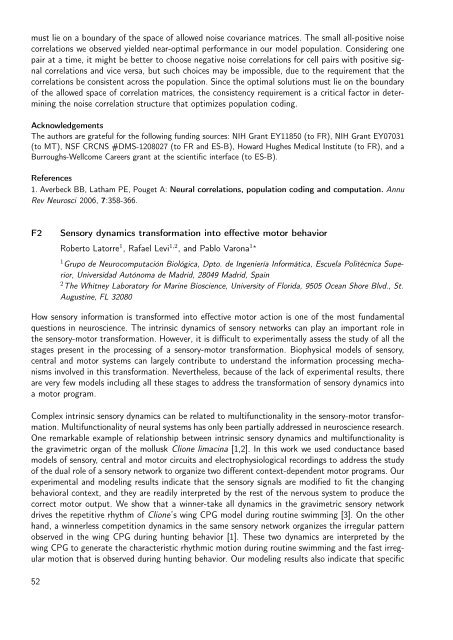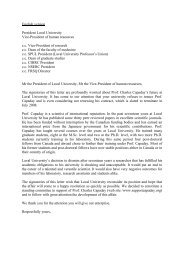Untitled - Laboratory of Neurophysics and Physiology
Untitled - Laboratory of Neurophysics and Physiology
Untitled - Laboratory of Neurophysics and Physiology
You also want an ePaper? Increase the reach of your titles
YUMPU automatically turns print PDFs into web optimized ePapers that Google loves.
must lie on a boundary <strong>of</strong> the space <strong>of</strong> allowed noise covariance matrices. The small all-positive noise<br />
correlations we observed yielded near-optimal performance in our model population. Considering one<br />
pair at a time, it might be better to choose negative noise correlations for cell pairs with positive signal<br />
correlations <strong>and</strong> vice versa, but such choices may be impossible, due to the requirement that the<br />
correlations be consistent across the population. Since the optimal solutions must lie on the boundary<br />
<strong>of</strong> the allowed space <strong>of</strong> correlation matrices, the consistency requirement is a critical factor in determining<br />
the noise correlation structure that optimizes population coding.<br />
Acknowledgements<br />
The authors are grateful for the following funding sources: NIH Grant EY11850 (to FR), NIH Grant EY07031<br />
(to MT), NSF CRCNS #DMS-1208027 (to FR <strong>and</strong> ES-B), Howard Hughes Medical Institute (to FR), <strong>and</strong> a<br />
Burroughs-Wellcome Careers grant at the scientific interface (to ES-B).<br />
References<br />
1. Averbeck BB, Latham PE, Pouget A: Neural correlations, population coding <strong>and</strong> computation. Annu<br />
Rev Neurosci 2006, 7:358-366.<br />
F2<br />
Sensory dynamics transformation into effective motor behavior<br />
Roberto Latorre 1 , Rafael Levi 1,2 , <strong>and</strong> Pablo Varona 1⋆<br />
1 Grupo de Neurocomputación Biológica, Dpto. de Ingeniería Informática, Escuela Politécnica Superior,<br />
Universidad Autónoma de Madrid, 28049 Madrid, Spain<br />
2 The Whitney <strong>Laboratory</strong> for Marine Bioscience, University <strong>of</strong> Florida, 9505 Ocean Shore Blvd., St.<br />
Augustine, FL 32080<br />
How sensory information is transformed into effective motor action is one <strong>of</strong> the most fundamental<br />
questions in neuroscience. The intrinsic dynamics <strong>of</strong> sensory networks can play an important role in<br />
the sensory-motor transformation. However, it is difficult to experimentally assess the study <strong>of</strong> all the<br />
stages present in the processing <strong>of</strong> a sensory-motor transformation. Biophysical models <strong>of</strong> sensory,<br />
central <strong>and</strong> motor systems can largely contribute to underst<strong>and</strong> the information processing mechanisms<br />
involved in this transformation. Nevertheless, because <strong>of</strong> the lack <strong>of</strong> experimental results, there<br />
are very few models including all these stages to address the transformation <strong>of</strong> sensory dynamics into<br />
a motor program.<br />
Complex intrinsic sensory dynamics can be related to multifunctionality in the sensory-motor transformation.<br />
Multifunctionality <strong>of</strong> neural systems has only been partially addressed in neuroscience research.<br />
One remarkable example <strong>of</strong> relationship between intrinsic sensory dynamics <strong>and</strong> multifunctionality is<br />
the gravimetric organ <strong>of</strong> the mollusk Clione limacina [1,2]. In this work we used conductance based<br />
models <strong>of</strong> sensory, central <strong>and</strong> motor circuits <strong>and</strong> electrophysiological recordings to address the study<br />
<strong>of</strong> the dual role <strong>of</strong> a sensory network to organize two different context-dependent motor programs. Our<br />
experimental <strong>and</strong> modeling results indicate that the sensory signals are modified to fit the changing<br />
behavioral context, <strong>and</strong> they are readily interpreted by the rest <strong>of</strong> the nervous system to produce the<br />
correct motor output. We show that a winner-take all dynamics in the gravimetric sensory network<br />
drives the repetitive rhythm <strong>of</strong> Clione’s wing CPG model during routine swimming [3]. On the other<br />
h<strong>and</strong>, a winnerless competition dynamics in the same sensory network organizes the irregular pattern<br />
observed in the wing CPG during hunting behavior [1]. These two dynamics are interpreted by the<br />
wing CPG to generate the characteristic rhythmic motion during routine swimming <strong>and</strong> the fast irregular<br />
motion that is observed during hunting behavior. Our modeling results also indicate that specific<br />
52



